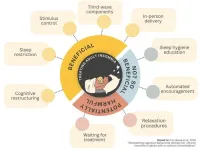(Press-News.org) Contacts:
David Hosansky, UCAR and NSF NCAR Manager of Media Relations
hosansky@ucar.edu
720-470-2073
Audrey Merket, UCAR and NSF NCAR Science Writer and Public Information Officer
amerket@ucar.edu
303-497-8293
The laws of thermodynamics dictate that a warmer atmosphere can hold more water vapor, but new research has found that atmospheric moisture has not increased as expected over arid and semi-arid regions of the world as the climate has warmed.
The findings are particularly puzzling because climate models have been predicting that the atmosphere will become more moist, even over dry regions. If the atmosphere is drier than anticipated, arid and semi-arid regions may be even more vulnerable to future wildfires and extreme heat than projected.
The authors of the new study, led by the U.S. National Science Foundation National Center for Atmospheric Research (NSF NCAR), are uncertain what’s causing the discrepancy.
“The impacts could be potentially severe,” said NSF NCAR scientist Isla Simpson, lead author of the study. “This is a global problem, and it’s something that is completely unexpected given our climate model results.”
Simpson and her co-authors say follow-up research is needed to determine why water vapor is not increasing. The reasons could have to do with moisture not moving from Earth’s surface into the atmosphere as projected or circulating around the atmosphere in unanticipated ways. It’s also possible that an entirely different mechanism could be responsible.
Adding to the mystery, the new study showed that while water vapor is increasing over humid regions of the world, it is not rising as much as expected during the most arid months of the year.
The study appears this week in the Proceedings of the National Academy of Sciences. The research was funded by the National Science Foundation, NOAA, and the U.S. Department of Energy. It was co-authored by scientists from the University of California, Los Angeles; University of California, Santa Barbara; Cornell University; Polar Bears International; and Columbia University.
A surprising finding
A basic rule of climate science is that the atmosphere can hold more moisture as it warms. This is known as the Clausius-Clapeyron relationship, and it’s the reason climate models consistently project that atmospheric water vapor will increase as the planet becomes warmer.
But when Simpson was working on a report for NOAA in 2020 about climate change in the southwestern United States, she realized that the atmosphere there had been drying much more than would be expected based on climate model simulations.
Intrigued, Simpson and her co-authors looked at the atmosphere globally to determine if water vapor was increasing in line with climate projections. The research team turned to multiple sources of observations from 1980 to 2020. These included networks of weather stations as well as datasets that estimate humidity based on observations from sources such as weather balloons and satellites.
To their surprise, the scientists found that water vapor over arid and semi-arid regions was generally remaining constant instead of increasing by close to 7% for every 1° Celsius (1.8° Fahrenheit) of warming, as would be expected based on the Clausius-Clapeyron relationship. Water vapor actually declined over the Southwest United States, which has seen a long-term reduction in precipitation.
“This is contrary to all climate model simulations in which it rises at a rate close to theoretical expectations, even over dry regions,” the authors wrote in the new paper. “Given close links between water vapor and wildfire, ecosystem functioning, and temperature extremes, this issue must be resolved in order to provide credible climate projections for arid and semi-arid regions of the world.”
The study noted that the situation is leading to an increase in vapor pressure deficit, which is the difference between the amount of moisture that the atmosphere can hold and the amount that’s actually in the air. When the deficit rises, it can act as a critical driver of wildfires and ecosystem stress.
“We could be facing even higher risks than what’s been projected for arid and semi-arid regions like the Southwest, which has already been affected by unprecedented water shortages and extreme wildfire seasons,” Simpson said.
She and her colleagues found a more complex situation in humid regions, where atmospheric water vapor increased as projected by climate models during wetter seasons. This increase leveled off somewhat during the driest months but did not flatten out as much as in arid and semi-arid regions.
Looking for the culprit
As for the question of why the water vapor in the atmosphere is not increasing over dry regions as expected, the authors broadly suggest two possibilities: the amount of moisture that is being moved from the land surface to the air may be lower than in models, or the way that the atmosphere is transporting moisture into dry regions may differ from the models.
Issues with atmospheric transport are less likely, they conclude, because that wouldn’t necessarily explain the common behavior among all arid and semi-arid regions worldwide, which receive moisture from differing locations.
That leaves the land surface as the most likely culprit. The authors speculate several possible causes: the land may have less water available to the atmosphere in reality than in models, it may be drying out more than anticipated as the climate warms, or plants may be holding on to moisture more effectively and releasing less into the atmosphere.
The authors also considered the possibility that there is an error in the observations. But they concluded this was unlikely since the discrepancy is closely tied to the dryness of regions all over the world, and it is consistently found even when dividing up the record into shorter time segments to avoid errors due to instrumentation changes.
Simpson emphasized that more research is needed to determine the cause.
“It is a really tricky problem to solve, because we don't have global observations of all the processes that matter to tell us about how water is being transferred from the land surface to the atmosphere," she said. "But we absolutely need to figure out what's going wrong because the situation is not what we expected and could have very serious implications for the future.”
This material is based upon work supported by the National Center for Atmospheric Research, a major facility sponsored by the National Science Foundation and managed by the University Corporation for Atmospheric Research. Any opinions, findings and conclusions or recommendations expressed in this material do not necessarily reflect the views of the National Science Foundation.
About the article
Title: “Observed humidity trends in dry regions contradict climate models”
Authors: Isla R. Simpson, Karen A. McKinnon, Daniel Kennedy, David M. Lawrence, Flavio Lehner, and Richard Seager
Publication: Proceedings of the National Academy of Sciences
On the web: news.ucar.edu
On X: @NCAR_Science
END
Climate change isn’t producing expected increase in atmospheric moisture over dry regions
Arid and semi-arid areas may face especially high risks of extreme heat and fire
2024-01-17
ELSE PRESS RELEASES FROM THIS DATE:
New research highlights unprecedented targeted approach to treating triple-negative breast cancer
2024-01-17
Cleveland Clinic researchers have successfully developed a therapeutic peptide that blocks aggressive cancer cells from multiplying rapidly. The results highlight a potential new strategy for developing targeted treatments for triple-negative breast cancer, which currently has no approved options.
Targeted drugs attack cancer cell functions directly, offering a more precise approach to complement broader treatments like chemotherapy. A research team led by Ofer Reizes, PhD, and Justin Lathia, PhD, designed a peptide therapeutic that disrupts the molecular processes behind aggressive cancer growth when delivered into cells.
The ...
ASBMB names Mona V. Miller as next executive officer
2024-01-17
The American Society for Biochemistry and Molecular Biology today named Mona V. Miller its next chief executive officer, effective April 1.
Miller is an experienced association leader with significant experience in strategic planning, advocacy and fundraising. Most recently, she was CEO of the American Society of Human Genetics. Before that she held multiple high-level positions at the Society for Neuroscience.
Miller said she was drawn to the ASBMB because “scientifically, biochemistry and molecular biology is at the forefront of knowledge that is transforming health and society.”
She said she looks forward to “focusing on the pivotal ...
Streamlining cognitive behavioral therapy for chronic insomnia
2024-01-17
A combination of cognitive and behavioral strategies, ideally delivered in person by a therapist, maximizes the benefits of cognitive behavioral therapy for insomnia (CBT-I), according to new research. CBT-I is a form of talk therapy, which can be delivered in person or through self-help guides. By analyzing 241 studies, involving over 30,000 adults, researchers identified the most beneficial components of CBT-I. These included: cognitive restructuring, third-wave components, sleep restriction, stimulus control and in-person delivery. Self-help with human encouragement could also be beneficial, while waiting for active treatment and enforcing ...
Prenatal opioid exposure and immune-related conditions in children
2024-01-17
About The Study: Prenatal opioid exposure was associated with an increased risk of infection, eczema and dermatitis, and asthma, but not allergies and anaphylaxis or autoimmune conditions in this study of 401,000 neonates. These findings highlight the importance of further study of opioid-induced immune changes during pregnancy, the potential impact on long-term health in exposed children, and the mechanisms of opioid-induced immune dysregulation.
Authors: Erin Kelty, Ph.D., of the University of Western Australia in Crawley, Western Australia, ...
Comparative effectiveness of psychotherapy vs antidepressants for depression in heart failure
2024-01-17
About The Study: In this comparative effectiveness trial of behavioral activation psychotherapy (BA) and antidepressant medication management (MEDS) in 416 patients with heart failure experiencing depression, both treatments significantly reduced depressive symptoms by nearly 50% with no statistically significant differences between treatments. BA recipients experienced better physical health-related quality of life, fewer emergency department visits, and fewer days hospitalized. The study findings suggest that patients with heart failure could be given the choice between BA or MEDS to ameliorate depression.
Authors: Waguih ...
Origin of intense light in supermassive black holes and tidal disruption events revealed
2024-01-17
A new study by Hebrew University is a significant breakthrough in understanding Tidal Disruption Events (TDEs) involving supermassive black holes. The new simulations, for the first time ever, accurately replicate the entire sequence of a TDE from stellar disruption to the peak luminosity of the resulting flare. This study has unveiled a previously unknown type of shockwave within TDEs, settling a longstanding debate about the energy source of the brightest phases in these events. It confirms that shock dissipation powers the brightest weeks ...
Astronomers detect oldest black hole ever observed
2024-01-17
Researchers have discovered the oldest black hole ever observed, dating from the dawn of the universe, and found that it is ‘eating’ its host galaxy to death.
The international team, led by the University of Cambridge, used the NASA/ESA/CSA James Webb Space Telescope (JWST) to detect the black hole, which dates from 400 million years after the big bang, more than 13 billion years ago. The results, which lead author Professor Roberto Maiolino says are “a giant leap forward”, are reported ...
Columbia chemists create the first 2D heavy fermion
2024-01-17
Researchers at Columbia University have successfully synthesized the first 2D heavy fermion material. They introduce the new material, a layered intermetallic crystal composed of cerium, silicon, and iodine (CeSiI), in a research article published today in Nature.
Heavy fermion compounds are a class of materials with electrons that are up to 1000x heavier than usual. In these materials, electrons get tangled up with magnetic spins that slow them down and increase their effective mass. Such interactions are ...
Therapy versus medication: comparing treatments for depression in heart disease
2024-01-17
New research by investigators from the Department of Psychiatry and Behavioral Neurosciences at Cedars-Sinai shows that behavioral activation therapy is as effective as antidepressant medications in treating symptoms of depression in patients with heart failure.
Heart failure affects nearly 6 million adults in the United States, and approximately 50% of heart failure patients experience symptoms of depression along with their condition. Past studies show patients with heart failure and depression have lower cardiac function, more emergency department ...
Active membranes: The future of fresh water is bright
2024-01-17
The growth of Los Angeles as a startup hub is highlighted by a robust and diverse entrepreneurial ecosystem within UCLA. The Magnify Incubator at CNSI is no exception to showcasing the range of early-stage businesses.
One such company within the Magnify incubator, Active Membranes, is innovating the future of fresh water through membrane desalination. As freshwater is becoming increasingly scarce around the globe, resources such as seawater and industrial wastewater are costly to procure and operate. The company’s patented technology is electrically conducting ...
LAST 30 PRESS RELEASES:
Tracing the quick synthesis of an industrially important catalyst
New software sheds light on cancer’s hidden genetic networks
UT Health San Antonio awarded $3 million in CPRIT grants to bolster cancer research and prevention efforts in South Texas
Third symposium spotlights global challenge of new contaminants in China’s fight against pollution
From straw to soil harmony: International team reveals how biochar supercharges carbon-smart farming
Myeloma: How AI is redrawing the map of cancer care
Manhattan E. Charurat, Ph.D., MHS invested as the Homer and Martha Gudelsky Distinguished Professor in Medicine at the University of Maryland School of Medicine
Insilico Medicine’s Pharma.AI Q4 Winter Launch Recap: Revolutionizing drug discovery with cutting-edge AI innovations, accelerating the path to pharmaceutical superintelligence
Nanoplastics have diet-dependent impacts on digestive system health
Brain neuron death occurs throughout life and increases with age, a natural human protein drug may halt neuron death in Alzheimer’s disease
SPIE and CLP announce the recipients of the 2025 Advanced Photonics Young Innovator Award
Lessons from the Caldor Fire’s Christmas Valley ‘Miracle’
Ant societies rose by trading individual protection for collective power
Research reveals how ancient viral DNA shapes early embryonic development
A molecular gatekeeper that controls protein synthesis
New ‘cloaking device’ concept to shield sensitive tech from magnetic fields
Researchers show impact of mountain building and climate change on alpine biodiversity
Study models the transition from Neanderthals to modern humans in Europe
University of Phoenix College of Doctoral Studies releases white paper on AI-driven skilling to reduce burnout and restore worker autonomy
AIs fail at the game of visual “telephone”
The levers for a sustainable food system
Potential changes in US homelessness by ending federal support for housing first programs
Vulnerability of large language models to prompt injection when providing medical advice
Researchers develop new system for high-energy-density, long-life, multi-electron transfer bromine-based flow batteries
Ending federal support for housing first programs could increase U.S. homelessness by 5% in one year, new JAMA study finds
New research uncovers molecular ‘safety switch’ shielding cancers from immune attack
Bacteria resisting viral infection can still sink carbon to ocean floor
Younger biological age may increase depression risk in older women during COVID-19
Bharat Innovates 2026 National Basecamp Showcases India’s Most Promising Deep-Tech Ventures
Here’s what determines whether your income level rises or falls
[Press-News.org] Climate change isn’t producing expected increase in atmospheric moisture over dry regionsArid and semi-arid areas may face especially high risks of extreme heat and fire




